Pigeon Removal, Control St Louis, Mo Missouri Falconry Based
314-399-8272
Pigeon droppings deface many roofs, monuments, and public spaces. The uric acid (white material) in their droppings is not just unsightly; it can damage the finish on buildings, automobiles, etc. Droppings also contain dangerous fungi and bacteria that are potentially harmful to humans. Some of these include Histoplasmosis, Cryptococcosis, Psittacosis, and St. Louis Encephalitis. When birds occupy warehouses and defecate on stored goods, this creates an expensive problem for the warehouse management when their customers (retailers) refuse to accept contaminated goods. Pigeons are not protected by federal law; however, you should check your state’s guidelines concerning their protection status and which methods of bird control are allowed before taking action against them. This article provides different methods for you to consider using, depending on your particular context. 314-399-8272
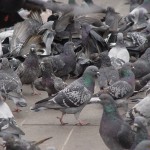
Falconry based bird removal and control of unwanted avian species
When faced with a pigeon control problem the first response is usually to investigate the pest control marketplace for an appropriate pigeon deterrent device or pigeon exclusion product only to find that there is a huge volume of commercially available pigeon deterrents available and confusion inevitably sets in. With the advent of the Internet and home shopping this plethora of products is available to us all at the click of a button and yet how do we identify the product that will resolve the pigeon control problem that we are experiencing? Is it possible to install a DIY pigeon deterrent system? There appears to be little or no truly independent and impartial advice available and every manufacturer seems to be making conflicting claims about the effectiveness of their particular pigeon control product. Many of the commercially available pigeon deterrents and services appear to be expensive and there are a considerable number of grey areas, certainly where pigeon control services are concerned.

Pigeon Bird Removal Control
So where do you start? Do you just take a chance and order a commercial pigeon deterrent over the Internet without really understanding how or why the product is effective? Do you contact a pest control company and ask for advice or a service? Do you ignore the problem and hope it goes away?
The purpose of this page, therefore, is to de-mystify the whole process of dealing with a pigeon-related problem without the need to call in a specialist contractor or, indeed, buy any conventional pest control products. There are methods of deterring pigeons from a property or a site without the need to spend huge sums of money and these controls can be just as effective and aesthetically pleasing as their commercially available counterparts. 314-399-8272
So how do you go about understanding which of these pigeon-related problems it is that you are experiencing? Over the period of a few days watch the movements of the pigeons and observe if they are active on the property throughout the day or whether they are only there first thing in the morning and then again an hour or two before dusk. If most of the activity is seen during the daytime, particularly on the upper reaches of the building (i.e. roof areas or top-storey windowsills and guttering), and there is no obvious sign of the birds on the property after dusk or during darkness, then it is likely that you are experiencing a daytime perching problem where the birds are using your property as a vantage point to exploit a food source. If, however, there is increased pigeon activity in the late afternoon or early evening and then again at dawn, with only limited pigeon activity during daylight hours, then it is likely that the birds are roosting overnight and/or possibly breeding on your property.

Falconry Based Pigeon Removal Service
So now you will hopefully have a better idea of why the pigeons are on your property and therefore be in a much better position to choose the correct pigeon deterrent, assuming that it is pigeon deterrents that you need. It is not always the case that deterrents alone will resolve a pigeon-related problem, particularly where overnight roosting and breeding-related issues are concerned or where pigeons are being deliberately fed within sight of a building that is experiencing problems.
Because of the homing ability of pigeons, there are difficulties with relocation. This species of bird was once used as a messenger between civilizations, finding their way over hundreds and thousands of miles. The only way to get rid of pigeons is to discourage them and prevent them from frequenting undesired locations. There are a number of ways to accomplish this, some proven to show more success than others. Information about pigeon trapping – analysis and methods for how to trap. 314-399-8272
Unsuccessful methods of pigeon control deal mostly with predator fear. Plastic owls are a favorite of the public when, in reality, the fake predator appears as just that—fake. A pigeon will not be any more leery of an unmoving owl than it would an unmoving human. Pigeons are largely unaffected by unpleasant smells, though it has recently been proven that their homing ability is based on scent mapping and not electromagnetic fields. Sounds are another flop when it comes to pigeon control. Ultrasonic sound emitters may very well produce noises humans can’t hear, but rarely are those sounds ‘annoying’ to birds. If a pigeon can put up with all the noise congestion in a busy city, some random sounds from an ultrasonic radio aren’t going to bother it.
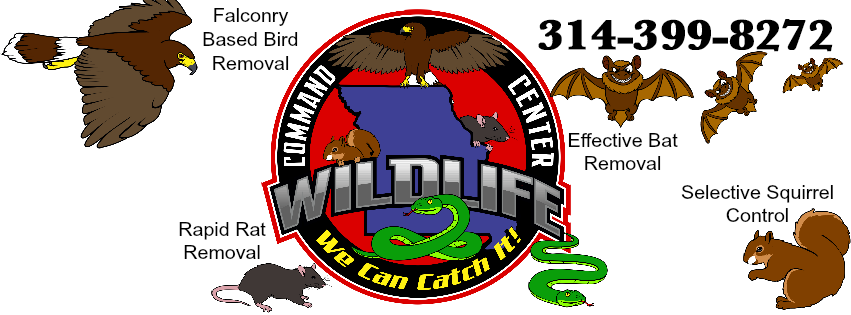
Click Here Like Us On Face Book
The most practical ways to get rid of pigeons is to convince them that they do not or cannot stay near your home or business. Any ledge can be a roosting site. By installing pigeon nets, bird spikes or electric shockers, pigeons will be less inclined to settle on those surfaces. Nets and spikes prevent roosting all together. Electric strips may be difficult to install at higher locations, but many brands offer solar power and require little maintenance. Electric strips do require more attention than netting and are often more expensive. If your building has smaller sections of roof, bird “spiders” are useful instruments. The wire device resembles a sprinkler in design with thin lines of arced metal extending outward from a central location. These wires are loose and are not strong enough to support the weight of a bird. Information about how to keep pigeons away – prevention techniques.
There is something to be said for determination, too. Even though most scare tactics do not work on pigeons, harassment techniques can prove beneficial if done frequently and without fail. If pigeons have taken over your yard, letting your dog out will chase them away. Yes, they will come back when the dog is gone, but if this scenario is repeated often enough the pigeons will learn that your yard is not the easiest place to visit. When it comes to opportunistic birds, life is all about easy.
Some towns and cities have experimented with employing the use of falcons to control pigeon populations. The benefit to using birds of prey is that they often keep the pigeons moving, preventing any one roosting area to become long-term. Unfortunately, falcons cannot eliminate a large enough number of the nuisance birds to make a noticeable difference without becoming a nuisance bird themselves.

St Louis, Missouri wildlife removal servivces
Pigeons are products of their environment. If they were not deliberately fed in parks and on streets a decline in their nuisance behaviors would be seen. These birds can live on naturally occurring food sources. Unfortunately, it is the poor sanitation habits of people that keep these animals desiring our leftovers. If pigeons have overrun your home, be sure that all garbage and compost is carefully disposed of. You may not be able to control the habits of the neighbors on your block, but you can make your house that much more uninviting by following good hygiene habits. 314-399-8272
Pigeon Appearance: Pigeons are robust birds with short necks, usually gray in color with a faint iridescence to their feathers. They have a characteristic back and forth rhythm to their head. This bobbing is a mechanism that allows the birds to focus their vision and perceive depth. Pigeons have duplicate black bands on each wing, but the coloration on the main part of the body can vary. Their feet are suited for perching on ledges and high peaks. The beak of the pigeon is medium in both length and width, ideal for pulling apart bread, picking up small food pieces, or fishing spiders out of cracks.
Pigeon Habitat and Behavior: Pigeons are most often seen in cities. This habitat preference is largely due to the surplus of food available and the high roosting opportunities. Pigeons are fond of the water towers on tall buildings, often building messy nests on the rim. For this reason, most cities require water towers be completely sealed to prevent the birds or their waste from contaminating the water supply. A pigeon will nest almost anywhere and will often do so with many others of its kind. A roost can be made atop any vertical surface. Pigeons are known in invade gutters, ducts, air conditioners, attics, warehouses, and drains. They are not overly concerned with sanitary conditions and will utilize any vertical object in any location for their purposes.
Pigeons are also very food-driven. This problem has been made serious by the continued, deliberate feeding of the birds in urban areas. The birds have little fear of humans and will often converge around people in parks and near restaurants. Pigeon feeding is a common hobby of many city-goers, yet another reason for the lack of caution around humans.
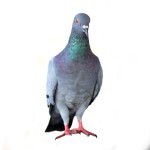
Falconry Based Pigeon Removal Control
Egg laying can take place as often as every other month. Courtship between the male and the female is brief, and the resulting egg clutch usually only contains two eggs. An abundance of pigeons will result in quick overpopulation, regardless of how many eggs are laid per pair. Some cites have sought population control by replacing viable eggs with fake or unfertilized eggs. This tactic may be effective short-term, but pigeons will lay another clutch once the original appears unproductive.
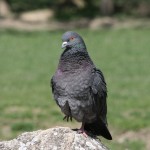
Falconry Based Pigeon Removal Control
Pigeon Diet: Pigeons will scavenge for almost any type of grain-based food source. The habit of city restaurants discarding stale bread into parks increases the role this type of food plays in the pigeon diet. In nature, the birds eat insects, berries, seeds, grains, and spiders.
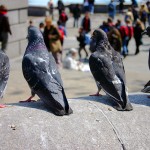
Falconry Based Pigeon Removal Control
Pigeon Nuisance Concerns: Pigeons are not as bold as some species of birds adapted to living off human leftovers. The major concern when it comes to this species centers on its roosting habits. Pigeons most often roost in number. They are not a sanitary bird, often eliminating waste in their own nests, and living on top of the bodies of their own kind. Pigeon waste is caustic and will do permanent damage to stone and concrete. In many cities, water contamination due to pigeons and their droppings has been a major concern. Because these birds pool around areas with a high opportunity for food (such as restaurants), there is a logical concern for public health.
Pigeon Diseases: The most common zoonotic disease associated with pigeons is called histoplasmosis. This disease is caused by a fungal infection facilitated by the dried powder of pigeon feces. People with compromised immune systems should also be wary of cryptococcosis, another fungal infection affecting only those without healthy defenses. Psittacosis, more commonly transmitted by exotic birds, has been reported in larger cities. These illnesses present with flu-like symptoms, making diagnosis and treatment difficult unless the disease is well underway.
This site is intended to provide pigeon education and information, so that you can make an informed decision if you need to deal with a pigeon problem. This site provides many pigeon control articles and strategies, if you wish to attempt to solve the problem yourself. If you are unable to do so, which is likely with many cases of pigeon removal, please go to the home page and click contact, where I have wildlife removal experts, who can properly help you with your nuisance pigeon.
Pigeon Removal, Control St Louis, Mo Missouri Falconry Based 314-399-8272


